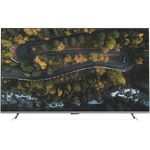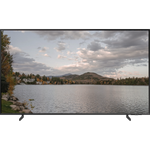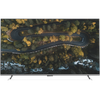A comparison of specs, key information, reviews, and best pricing from top retailers
Last updated -- hours ago | Report incorrect information
What we think

The PerfectRec TV team Learn more
Updated January 10, 2024·
When choosing between the Amazon Omni Series and the Samsung Q60B, consider these tradeoffs: If price is a primary concern and you're looking for a more affordable option, the Amazon Omni Series is less expensive. On the other hand, if you prefer a TV with overall better picture quality and performance in bright rooms, the Samsung Q60B is a superior choice, although it comes at a higher cost. Give Feedback
this description is based on the product variant with some specs and product variant with some specs. At the time of writing, the variant with some specs cost some dollars and the variant with some specs cost some dollars.
Advantages of the Amazon Omni Series (LCD)
- The Amazon Omni Series (LCD) has no clear advantages over the Samsung Q60B (LCD).
Advantages of the Samsung Q60B (LCD)
- Good for bright room
- Good for news, talk, & other TV
- Very good for cartoons & animation
- Good for upscaling
- Good motion processing
Key differences
Picture Quality
6.1


7.3
7.38/10
CONTRAST
7.75/10
6.2/10
COLOR VOLUME SCORE
7.2/10
LED
PANEL TYPE
LED
VA
PANEL SUB-TYPE
VA
The Samsung Q60B (LCD) has good picture quality, while the Amazon Omni Series (LCD) has only fair picture quality.
Movies & TV
5.6


6.6
7.38/10
CONTRAST
7.75/10
6.4/10
BLACK UNIFORMITY
8.5/10
6.6/10
UPSCALING
7.5/10
Yes
HDR10 SUPPORT
Yes
No
HDR10+ SUPPORT
Yes
Yes
DOLBY VISION SUPPORT
No
The Samsung Q60B (LCD) is only fair for movies & TV, while the Amazon Omni Series (LCD) is poor.
The Amazon Omni Series struggles with movie and cinematic TV viewing primarily because it has no local dimming feature and below-average black uniformity, impacting contrast during dark scenes. In contrast, the Samsung Q60B offers better black uniformity which enhances contrast, but also lacks local dimming, which means neither are optimal for movie experiences that often rely on deep blacks and high contrast.
Sports
5.8


6.4
2.5/10
MOTION PROCESSING
7.0/10
60Hz
REFRESH RATE
60Hz
8.0/10
INPUT LAG SCORE
10.0/10
6.6/10
UPSCALING
7.5/10
7.3/10
SDR BRIGHTNESS SCORE
8.3/10
Yes
HLG SUPPORT
Yes
The Samsung Q60B (LCD) is only fair for sports, while the Amazon Omni Series (LCD) is poor.
While watching sports, the Samsung Q60B offers better motion processing and handles reflections more effectively than the Amazon Omni Series, making the action on screen clearer and less affected by ambient light. However, both models have similar viewing angles, which means the picture quality doesn't change much when viewed from the side, but the Samsung Q60B has a slight edge in gray uniformity, which can result in a more consistent image across the screen.
Cartoons & Animation
5.8


8.4
5.9/10
COLOR GAMUT SCORE
7.2/10
6.2/10
COLOR VOLUME SCORE
7.2/10
7.3/10
SDR BRIGHTNESS SCORE
8.3/10
5.2/10
COLORS OUT OF THE BOX SCORE
9.1/10
6.0/10
GRAY UNIFORMITY
7.2/10
The Samsung Q60B (LCD) is very good for cartoons & animation, while the Amazon Omni Series (LCD) is poor.
News, Talk, & Other TV
6.0


7.6
7.3/10
SDR BRIGHTNESS SCORE
8.3/10
6.6/10
UPSCALING
7.5/10
The Samsung Q60B (LCD) is good for news, talk, & other TV, while the Amazon Omni Series (LCD) is only fair.
Bright Room
6.3


7.1
5.3/10
VIEWING ANGLE
5.3/10
7.3/10
SDR BRIGHTNESS SCORE
8.3/10
5.7/10
HDR BRIGHTNESS SCORE
6.7/10
5.9/10
REFLECTIONS SCORE
6.3/10
The Samsung Q60B (LCD) is good for bright room, while the Amazon Omni Series (LCD) is only fair.
The Samsung Q60B exhibits better performance in a bright room mainly because it has higher SDR and HDR brightness compared to the Amazon Omni Series, and its ability to handle reflections is rated higher, which minimizes glare. In contrast, the Omni Series, despite its fair color volume and contrast that could enhance picture quality, doesn't get as bright and struggles more with reflections, which makes it less suitable for well-lit environments.

Let Us Help Find Your Perfect TV
Find your new TV
Key similarities
Gaming
5.6


5.6
6.0/10
RESPONSE TIME SCORE
5.2/10
8.0/10
INPUT LAG SCORE
10.0/10
2.5/10
MOTION PROCESSING
7.0/10
0.0/100
GAMING LOCAL DIMMING
0.0/100
5.9/10
GAME HDR BRIGHTNESS SCORE
6.9/10
The Amazon Omni Series (LCD) and Samsung Q60B (LCD) are both poor for gaming.
The Amazon Omni Series is less suited for gaming due to its merely fair response time and fair input lag, which might result in slower reaction to in-game events and less fluid motion. On the other hand, the Samsung Q60B, although it has excellent input lag, making it very responsive, its response time is poor, risking blurry images when fast-moving content is displayed.
Cost
$1,050


$1,098
$400
$600
$800
$1,000
$1,200
$1,400
$1,600
$1,800
The Amazon Omni Series (LCD) has a price of $1,050 and the Samsung Q60B (LCD) costs $1,098.
Give feedback
We’re constantly working to improve.
How the Amazon Omni Series (LCD) and the Samsung Q60B (LCD) compare to other TVs
Spec Comparison
| Amazon Omni Series (LCD) | Samsung Q60B (LCD) |
GENERAL | |||
|---|---|---|---|
| Price | |||
$1,050 | $1,098 | ||
Brand | |||
Brand | Amazon | Samsung | |
Release Date | |||
Release Date | September 5, 2021 | April 7, 2022 | |
Full name | |||
Full name | 4K75M600A | QN75Q60B | |
Screen Size | |||
Screen Size | 75" | 75" | |
Screen Resolution | |||
Screen Resolution | 4K | 4K | |
TV FEATURES | |||
|---|---|---|---|
Operating System | |||
Operating System | Fire OS | Tizen | |
Sound Quality Score | |||
Sound Quality Score | 6.3/10 | 5.9/10 | |
NextGen Ready | |||
NextGen Ready | No | No | |
HDMI Ports | |||
HDMI Ports | 4 | 3 | |
Coax Ports | |||
Coax Ports | 1 | 1 | |
DISPLAY QUALITY SCORES | |||
|---|---|---|---|
Picture Quality Score | |||
Picture Quality Score | 6.2/10 | 7.3/10 | |
Bright Room Score | |||
Bright Room Score | 6.3/10 | 7.1/10 | |
Gaming Score | |||
Gaming Score | 5.7/10 | 5.6/10 | |
Movies & TV Score | |||
Movies & TV Score | 5.7/10 | 6.7/10 | |
Sports Score | |||
Sports Score | 5.9/10 | 6.4/10 | |
PHYSICAL | |||
|---|---|---|---|
Dimensions w/o Stand (H x W x D) | |||
Dimensions w/o Stand (H x W x D) | 38.2" x 65.9" x 3" | 37.8" x 66" x 1" | |
Dimensions with Stand (H x W) | |||
Dimensions with Stand (H x W) | 40.2" x 65.9" | 39.3" x 66" | |
Weight without Stand | |||
Weight without Stand | 62.2 lbs | 69.2 lbs | |
VESA Mount | |||
VESA Mount | 400 x 300 | 400 x 400 | |
DISPLAY | |||
|---|---|---|---|
Color Depth | |||
Color Depth | 10 bit | 10 bit | |
Black Frame Insertion | |||
Black Frame Insertion | No | Yes | |
Auto Low Latency Mode | |||
Auto Low Latency Mode | Yes | Yes | |
Contrast | |||
Contrast | 7.4/10 | 7.8/10 | |
Local Dimming | |||
Local Dimming | 2.5/10 | 2.5/10 | |
SOUND | |||
|---|---|---|---|
Speaker Setup | |||
Speaker Setup | 2.0 | 2.0 | |
Speaker Power | |||
Speaker Power | 16 W | 20 W | |
Dolby Atmos | |||
Dolby Atmos | Bypass only | Bypass only | |
DTS:X | |||
DTS:X | No | No | |
Shopping
Amazon Omni Series (LCD)
See more
Dig into reviews and images
Techradar
Nick Pino | July 2022
"If you want a competent budget screen with some handy features, the Amazon Omni TV delivers an experience that punches well above its price tag. You’ll also get the benefit of Fire TV’s new UI right out of the box. It’s clean and simple to understand, plus it puts content first. In the picture-quality department, the Amazon Omni is a surprising star among some of its dimmer, less colorful rivals."
Samsung Q60B (LCD)
See more
Dig into reviews and images
CNET
David Katzmaier | June 2022
"Samsung's 2022 QLED workhorse shines in bright rooms and with HDR. The Samsung Q60B stands out from the slew of entry-level TVs with an ultra-thin frame, a skinny profile from the side and even narrow stand legs. The Q60B is a very good bright-room TV, and my subjective impression of its ample light output was proven by measurements."
Get a great deal on the Amazon Omni Series (LCD) or the Samsung Q60B (LCD)
About Amazon
Amazon, the largest online retailer in North America, has forged partnerships with TCL and Hisense to produce white-label TVs incorporating their Fire OS software. These Amazon-branded TVs typically compete in the low-end and mid-range segments, offering compelling price points. Leveraging their strong reputation, Amazon has swiftly built brand trust in the TV market despite being relatively new to it. To enhance their popularity, these TVs integrate features from the Amazon ecosystem, including Alexa, providing users with a seamless and interconnected TV experience.
About Samsung
Samsung, a South Korean electronics manufacturer, holds the title of being the largest global TV vendor in terms of units sold. They offer a diverse lineup of TV products that cater to various budget ranges. A notable achievement in recent years is the development of Quantum Dots, a technology that enhances color reproduction, resulting in richer and more vibrant hues. Samsung TVs are well-regarded for their high manufacturing quality and user-friendly software, making them an excellent choice for consumers seeking an intuitive viewing experience.
Give feedback
We're constantly perfecting our model
TV guides you might be interested in
More comparisons for you
Compare Amazon Omni Series (LCD) vs. Samsung Q60C (LCD)
VS
Compare Amazon Omni Series (LCD) vs. Vizio Quantum Pro (LCD)
VS
Compare Amazon Omni Series (LCD) vs. Hisense U7H (LCD)
VS
Compare Samsung Q60B (LCD) vs. Sony X80K (LCD)
VS
Compare Samsung Q60B (LCD) vs. Amazon Omni QLED (LCD)
VS
Compare Samsung Q60B (LCD) vs. Hisense U7G (LCD)
VS
FAQs
FAQs about TVs
Why trust us
This information was produced and vetted by the PerfectRec TVs team. We are a product research and recommendation organization that meticulously reviews and evaluates the latest TV information and makes it digestible for you.
By the numbers
385
TVs evaluated
33,110
TVs stats compiled
21
Proprietary TVs ratings developed
129,630
Recommendations made
19,445
Consumer hours saved
About the TV team
Joe Golden, Ph.D
CEO and TVs Editor
Joe is an entrepreneur and lifelong electronics enthusiast with a Ph.D in Economics from the University of Michigan.
Jason Lew
Staff Expert & Software Engineer
Jason is a staff expert and software engineer that has been making laptop recommendations for 7 years and moderates one of the largest laptop subreddits.
Chandradeep Chowdhury
Staff Expert & Software Engineer
Chandradeep is a staff expert and software engineer and expert in televisions and monitors. He’s been making monitor recommendations for ten years.
Jaime Roldán
TVs Expert
Jaime is a Colombia-based TV expert. He is an electronics engineer with 8 years of experience in the telecom sector and has been making TV recommendations for 12 years.







